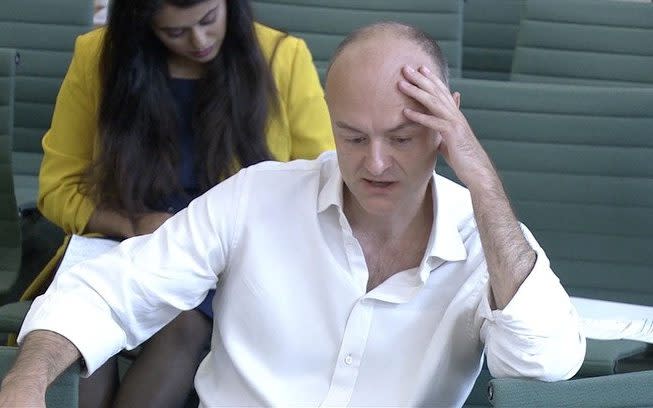Boris Johnson approved HS2 based on 'garbage data', Dominic Cummings says

- Oops!Something went wrong.Please try again later.
- Oops!Something went wrong.Please try again later.
Boris Johnson signed off on the £100 billion High Speed 2 rail line based on "garbage" data predicting an exponential increase in demand for the service, Dominic Cummings has claimed.
In a posting on the Substack website, the Prime Minister's former chief adviser, said that he and other officials had highlighted "absurdities" in the evidence presented to Mr Johnson to justify pressing ahead with the construction of the line last year.
But Mr Johnson "blew" the decision on whether to go ahead with the scheme having been presented with a "garbage model/graph", Mr Cummings wrote.
While his latest comments will deepen the rift between Mr Johnson and his former advisor, they will also add to the growing clamour for the controversial high-speed rail scheme connecting Northern cities to the capital to be scrapped. For years, senior Tories have warned it will not provide value for money.
Mr Cummings writes how in January 2020, Mr Johnson “was presented with ‘evidence’ showing exponential increase in HS2 demand - demand that, if taken seriously, would have meant the entire country either travelling on HS rail” and even “building HS3/HS4/HS5 in even shorter periods after 2040.”
Mr Johnson gave the project the go-ahead the following month, despite conceding its final cost would “probably be north of £100 billion.”

Mr Cummings wrote: “A garbage model/graph was fed to a PM making a [more than] £100 billion decision (which he blew despite us pointing out such absurdities in the ‘evidence’).”
He goes on to claim those same officials who produced the data were later responsible for trying to manage the “exponential Covid curve” and how once hospitals collapsed “the jump in deaths would not be nonlinear”.
He adds: “We escaped total disaster partly because we had started to bring into No10 people who could reason quantitatively and talk technically with the modellers, cutting out the layers of management and Powerpoint-creators that had obscured reality.
“We could then put accurate graphs in front of the PM and improve decisions.”
He accused “many organisations” of having relied on consultants “slotting in charts from models they don’t understand”. However, he claimed the most successful bosses “dispense with this model” and adopt a “new set of skills” to better thrive.
Last year, the Public Accounts Committee accused the Department for Transport (DfT) of withholding information about HS2’s spiralling costs, as MPs said they were “unconvinced” the budget would not increase yet further.
Sir Bernard Jenkin, a member of the committee, then wrote in The Telegraph how the “lack of transparency” regarding the planned rail link “undermines public confidence that HS2 is necessary or subject to accountable governance.”
The committee’s report noted how the High Speed 2 budget had soared from 55.7 billion to £88 billion, adding how they were also “not yet convinced the Department [of Transport] and HS2 have the skills and capability they need now or in the future.”
Last week, HS2 conceded the cost of the station in Birmingham had ballooned by £100 million before builders had even submitted bids to try to win the lucrative contract.
The Birmingham Interchange Station was originally expected to cost £270 million. It will now cost £370 million.
A Department for Transport spokesman said: “We do not recognise the evidence being referred to in the blog in question.
“The capacity of the existing rail network cannot cope with the predicted growth in demand for rail travel, with HS2 serving as a long-term investment at the heart of our plans to build back better from Covid-19, bringing our biggest cities closer together and boosting productivity for many decades to come.”

